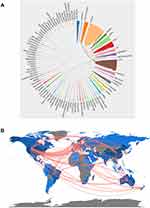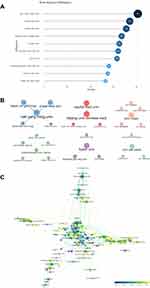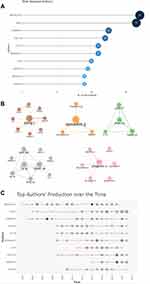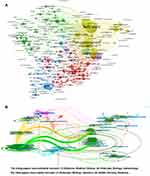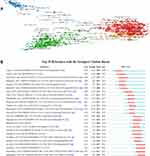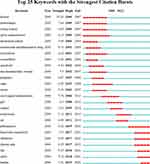Back to Journals » Journal of Pain Research » Volume 16
Bibliometric Analysis of Global Research Landscape and Hotspots on Dysmenorrhea: Where are We Now?
Authors Liu Z, Li Z , Meng Q, Gu Z, Cui J
Received 3 November 2022
Accepted for publication 4 January 2023
Published 28 January 2023 Volume 2023:16 Pages 269—285
DOI https://doi.org/10.2147/JPR.S396083
Checked for plagiarism Yes
Review by Single anonymous peer review
Peer reviewer comments 2
Editor who approved publication: Dr Ellen M Soffin
Zhihui Liu,1,* Zhuo Li,2,* Qian Meng,3 Zhenpeng Gu,4 Jinxiu Cui4
1Department of Obstetrics and Gynecology, Beijing Chaoyang Hospital, Capital Medical University, Beijing, People’s Republic of China; 2School of Medicine, Nankai University, Tianjin, People’s Republic of China; 3Department of Obstetrics and Gynecology, Zibo Maternal and Child Health Hospital, Zibo, People’s Republic of China; 4Department of Obstetrics and Gynecology, Binzhou Medical University Hospital, Binzhou, People’s Republic of China
*These authors contributed equally to this work
Correspondence: Jinxiu Cui, Department of Obstetrics and Gynecology, Binzhou Medical University Hospital, No. 661 Huanghe 2nd Road, Binzhou, Shandong Province, 256603, People’s Republic of China, Email [email protected]
Purpose: Dysmenorrhea is the most common gynecological condition among women of childbearing age and remains a challenging public health issue. This study aimed to visualize profiles and hotspots in dysmenorrhea research through a bibliometric analysis to deepen the understanding of knowledge in this field.
Methods: Articles and reviews on dysmenorrhea published from 2000 to 2021 were collected. We summarized standard bibliometric indicators. Publications were systematically assessed in terms of country, institution, author, journal, reference, and keywords using Citespace, VOSviewer, Bibliometric, and an online platform. Besides, correlation analyses of country-specific characteristics and bibliometric indicators were performed.
Results: 3407 publications were included. Dysmenorrhea-related publications have been increasing steadily annually. China and the United States were the most productive and academically influential countries, respectively. Correlation analysis revealed that economic power is an essential factor influencing scientific activity. However, collaboration in dysmenorrhea research remained weak. Natl Yang Ming Univ and Vercellini P were the most productive institution and influential author, respectively. A significant proportion of dysmenorrhea research was published in high-impact journals and it was explored at a multidisciplinary level. Current research topics focus on two primary areas: (1) pathophysiology, such as pathogenesis, oxidative stress, and functional connectivity, and (2) public health impacts, such as quality of life, burden, depression, and exercise.
Conclusion: Dysmenorrhea research has received extensive attention from scholars and is rapidly evolving. Improved collaboration and interdisciplinary exploration may advance this field. Public health research and pathophysiological exploration of dysmenorrhea are current research hotspots and may also be a focus of research in the coming years.
Keywords: bibliometric analysis, dysmenorrhea, women, pain, research hotspots
Introduction
Dysmenorrhea is recurrent episodes of moderate-to-severe lower abdominal pain occurring before or during menstruation, usually accompanied by systemic symptoms such as headache, nausea, and diarrhea.1 Primary dysmenorrhea is menstrual pain without a definite pelvic pathology. Changes in pain intensity and duration suggest the possible coexistence of underlying pelvic lesions, ie secondary dysmenorrhea, which requires further investigation. Dysmenorrhea is considered the most common gynecological condition among adolescents and young women, with prevalence rates reported in the literature varying from 16% to 95%, although it is likely highly underestimated.1–3 For many women, it is a debilitating disease that can negatively impact multiple aspects of an individual’s life, such as limited social interaction,4 reduced productivity,5 exacerbated psychological distress,6,7 increased medical expenditures,8 and even disability.9 In the United States alone, absenteeism due to menstrual pain results in a loss of approximately two billion dollars annually.10 While, in developing countries, it can pose a heavier disease burden than any other gynecological complaint.8 However, dysmenorrhea’s pathogenesis and risk factors are still not completely elucidated,1,11,12 and the optimal treatment strategy has not yet been determined.13
Given the aspects mentioned above, dysmenorrhea has become a significant public health issue and has received considerable attention from scholars.14 To date, a substantial amount of literature has been published in the field of dysmenorrhea, and the rapid accumulation of knowledge has made it increasingly tricky to identify critical information and track the latest research hotspots, especially for those new to the field. Furthermore, although some systematic reviews can provide conclusions from quantitative analyses, they currently focus on a specific subfield, eg, Armour et al15 investigated the prevalence of dysmenorrhea, while more studies focus on evaluating different treatment modalities.16,17 However, macroscopic analyses of this field, such as research profiles and the evolution of topics, are still unavailable. Although extensive research has been conducted on dysmenorrhea, various scientific issues related to dysmenorrhea still require continued academic exploration. Therefore, assessing the research performance in this field is necessary to better prepare for further studies.
The bibliometric analysis provides an excellent solution to systematically and quantitatively analyze large-scale publications, presenting the development history and scientific status.18 It has been employed in various primary care and public health fields, including COVID-19,19 chronic postsurgical pain,20 rheumatoid arthritis,21 and central sensitization.22 Whereas bibliometric analysis in the field of dysmenorrhea is scarce. This study aimed to comprehensively analyze the scientific publications on dysmenorrhea to provide a global perspective on the scientific performance and research hotspots in this field.
Materials and Methods
Data Source
We selected Science Citation Index Expanded (SCI-Expanded) as the search data source. SCIE includes a wide range of journals with academic impact in the natural sciences and is one of the well-recognized databases for conducting bibliometric research. In addition, reference files in various formats are available to meet the requirements of the bibliometric software directly.23
Searching Strategy
The included bibliography needs to be an original article or review. Two investigators conducted the bibliographic search independently and downloaded the bibliometric data in plain text or UTF-8 format. The search strategies were set as follows: TS (Topic) = (dysmenorrh* OR algomenorrh* OR menalgia OR menorrhalgia OR “menstrual pain”) AND Language= English AND Time= (2000–2021). A total of 3666 publications were retrieved, then 3407 publications were considered the final data set for further analysis after excluding document types such as editorial materials, corrections, conference proceedings, and correspondence. The bibliographic search and data retrieval was performed on September 5, 2022, to avoid any bias due to database updates.
Data Analysis and Visualization
The bibliometric indicators of publications were summarized, including the number of publications, sources, authors, affiliations, countries, keywords, references, and collaborations. A publication is defined as a multiple-countries publication (MCP, inter-country collaboration) if its authors are from at least two countries; otherwise, it is a single-country publication (SCP, intra-country collaboration). The citations, H-index or G-index, were used to assess the academic impact of authors or journals. Besides, we extracted the categories (Q1, Q2, Q3, and Q4) and impact factors (IF) of the journals from Journal Citation Reports (JCR) 2021. Moreover, the number of publications per million people and the number of publications per trillion gross domestic product (GDP) were evaluated, considering the unevenness in the economies and populations of different countries.23,24
To explore the association between the country’s demographic and economic status and academic impact, Spearman correlation analyses of country-specific characteristics (GDP, GDP per capita, and population size) and bibliometric indicators (number of publications, total citations, average article citations, percentage of MCP) were performed using SPSS 22.0 (IBM Corp., Armonk, NY, USA). A P-value< 0.05 was defined as statistically significant. We conducted a comprehensive bibliometric analysis by the Java-based Citespace (version 5.8.R3), VOSviewer (version 1.6.18), the R software-based Bibliometric (version 3.0), and an online analytics platform (https://bibliometric.com/). Co-citation, co-occurrence, collaborative, co-authorship analysis, burst detection, and a dual-map overlap of journals were performed to construct knowledge networks of dysmenorrhoea.
Results
General Information and Publication Trends
Table 1 presented the basic information of 3407 publications, including 2838 original articles and 569 reviews. These publications were written by 12,435 authors, published in 791 journals, and cited 76,027 references. The average number of citations per document was 25.94. Figure 1A showed the trend in annual publications of dysmenorrhea research. As can be seen, there is a noticeable upward trend in the number of publications and citations, peaking in 2021 with 332 publications and 11,206 citations.
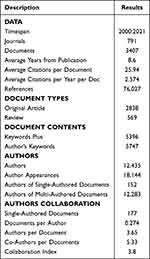 |
Table 1 Main Information About Bibliometric Analysis |
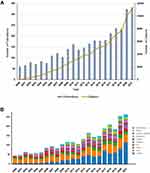 |
Figure 1 Annual publication trends worldwide (A) and in the top ten most productive countries (B). The number of studies related to dysmenorrhea has been increasing rapidly since the 21st century. |
Publication Performances: Countries
Dysmenorrhea-related publications came from 81 countries, indicating wide participation in this field. As shown in Table 2, China was the most productive country (n = 697, 20.6%), followed by the United States (US, n = 569, 16.8%) and Italy (n = 220, 6.5%). Of the top ten most productive countries, four are from Europe, four are from Asia, and the other two are from North America and Oceania. Publications from these ten countries are also on the rise, with an impressive increase in publications from China over the last decade (Figure 1B). After adjusting for population size and GDP, Australia ranked first with 4.4 publications per million people, and Iran was first with 102.3 publications per trillion GDP. As for the citations, the US ranked first (n = 18860 average article citation (AAC) = 33.2), followed by China (n = 9794, AAC = 14.1) and Italy (n = 9389, AAC = 42.7).
 |
Table 2 Top 10 Productive Countries and Citations per Country |
Moreover, correlation analysis revealed a moderate-to-high positive correlation between GDP and the number of publications (Table 3, r = 0.678, P= 0.001) or citations (r = 0.707, P< 0.001). A similar association was found for population size. GDP per capita, on the other hand, was positively correlated with the AAC (r = 0.561, P= 0.010) or the percentage of MCP (r = 0.788, P< 0.001). It indicated that literature from wealthy countries experienced more international collaborations and had a higher impact.
 |
Table 3 Correlation Analysis Between Country-Specific Characteristics and Bibliometric Indicators |
We constructed a collaborative network for dysmenorrhea research. Although international collaborations were widespread, the proportion of MCPs remained low (Figure 2A). Further mapping of collaborations on a global map revealed that collaborations were mainly clustered in US-Europe and US-China (Figure 2B).
Publication Performances: Institutions
Over 3200 institutions have contributed to the field of dysmenorrhea. As shown in Figure 3A, six of the top ten most productive institutions were from China, as Natl Yang Ming Univ ranks first with 81 publications. Six major clusters were identified in the collaborative network: Natl Yang Ming Univ, Beijing Univ Chinese Med, Univ Milan, Shahid Beheshti Univ, Fudan Univ, and Univ Sao Paulo at the center of the clusters, respectively (Figure 3B). Figure 3C demonstrated a detailed co-authorship analysis based on the timeline, highlighting the complex collaborative relationships between institutions, with collaborations primarily scattered across the United States, China, and Europe. Besides, many new institutions participating in dysmenorrhea research have emerged recently, such as Xi’an Jiao Tong Univ, Jilin Univ, Boston Children’s Hosp, and Indiana Univ Sch Med.
Publication Performances: Authors
Figure 4A demonstrated the top ten most productive authors, five of whom were from China. Vercellini P and Yang J ranked in the top two, with 34 and 33 publications, respectively. As for the most cited authors, Vercellini P received 3477 citations with an H-index of 26, followed by Chapron C and Fedele L with 3023 and 2105 citations, respectively (Table 4). It is noteworthy that the top ten most cited authors are all from developed countries in Europe and US. The collaborative network analysis revealed five major author clusters, with Vercellini P, Yang J, Chao HT, Liu P, and Chapron C at the center of their respective clusters (Figure 4B). All five authors were on the list of highly productive authors. We also analyzed the top authors’ production over time (Figure 4C). Vercellini P, Yang J, and Chapron C have been deeply involved in this field for almost 20 years. Most of the authors started working in dysmenorrhea research after 2007.
 |
Table 4 Top ten Most Cited Authors |
Highly Contributive Journals
Table 5 summarized the characteristics of the top productive journals, four of which belong to JCR Q1. The most productive journal was Fertility and Sterility, with 112 publications, and received a remarkable 7046 citations. Journal of Minimally Invasive Gynecology (n=100, citations=2310) and Journal of Pediatric and Adolescent Gynecology (n=84, citations=1294) came in second and third place. Fertility and Sterility also had the highest impact factor of 7.490. The complex co-citation network among journals was depicted in Figure 5A. It revealed several significant journal clusters, including the Obstetrics and Gynecology cluster represented by Fertility and Sterility, the Pain and Neuroscience cluster represented by Pain, the Public Health cluster represented by Cochrane Database of Systematic Reviews, and the Endocrinology and Basic Research cluster represented by J Clin Endocrinol Metab. Figure 5B showed a dual-map overlap of the research journals. The citing papers were primarily focused on two areas: (1) Medicine, Medical, Clinical; (2) Molecular, Biology, immunology. At the same time, the cited papers were mainly concentrated on: (1) Molecular, Biology, Genetics; (2) Health, Nursing, Medicine. The above results suggest that dysmenorrhea research has attracted widespread attention from various disciplines.
 |
Table 5 The Top 10 Most Productive Journals |
Highly Contributive Papers
We used local citations to assess the articles’ impact on dysmenorrhea research. The top three most contributing publications were three reviews by Dawood et al,25 Iacovides et al2 and Ju et al,1 which focused on the incidence, risk factors, pathogenesis, and advances in the management of dysmenorrhea. The co-citation network (Figure 6A) showed four major clusters containing many references, suggesting an extensive association between references. Figure 6B depicted the top 25 references with the strongest citation bursts, half of them were published after 2015. In 2021, publications authored by Iacovides et al2 Hailemeskel et al26 and Marjoribanks et al27 remained high academic impact. The study by Hailemeskel et al26 assessed the effect of primary dysmenorrhea on academic performance. While Marjoribanks et al27 explored the effectiveness and safety of non-steroidal anti-inflammatory drugs (NSAIDs) in treating primary dysmenorrhea.
Keyword Co-Occurrence
Keyword co-occurrence allowed us to identify research hotspots and thus deepen our understanding of knowledge in the field of dysmenorrhea. As shown in Figure 7A, the keywords can divide into five clusters. The blue clusters are mainly epidemiology-related keywords, including prevalence, female, risk factors, and adolescent. The cyan and green clusters correspond to two secondary dysmenorrhea conditions, endometriosis and adenomyosis. Pathogenesis-related terms such as expression, oxidative stress, and inflammation were concentrated in the red cluster. Additionally, the temporal evolution of the keywords was presented in Figure 7B. Emerging terms focus on two primary areas: (1) pathophysiology, such as mechanism, pathogenesis, oxidative stress, and functional connectivity, and (2) public health impacts, such as quality of life, anxiety, depression, and exercise. The keyword burst detection further confirmed the above results (Figure 8). Some keywords that emerged after 2015 and continue to be influential to 2021 include pathogenesis, functional connectivity, validation, chronic pain, life, safety, and burden.
Discussion
To our knowledge, this study is the first bibliometric analysis of dysmenorrhea research. We summarized 3407 original articles and reviews published from 2000 to 2021 to identify milestone achievements. We found that dysmenorrhea has received increasing attention from researchers, with related publications steadily growing annually. China and the United States were the most productive and academically influential countries, respectively, while economic power was an essential factor influencing scientific activity. Natl Yang Ming Univ and Vercellini P were the most productive institution and influential author, respectively. A significant proportion of dysmenorrhea research was published in high-impact journals and was explored at a multidisciplinary level. Current emerging topics focused on two primary areas: (1) pathophysiology, such as pathogenesis, oxidative stress, and functional connectivity, and (2) public health impacts, such as quality of life, burden, depression, and exercise. This report may serve as a reference and guide for more in-depth studies in the future.
The present study revealed that publications and citations about dysmenorrhea have continued to increase since the 21st century (Figure 1A). According to the above trends, we believe that dysmenorrhea has attracted broad interest from scholars and will remain a crucial topic with great potential in the future. This development trend may be related to the high prevalence of dysmenorrhea and the improved awareness of women’s health care. The prevalence of dysmenorrhea reported in the literature is not consistent.1–3 A recent meta-analysis included 21,573 young women from countries with different income levels and found a prevalence of dysmenorrhea as high as 71.1%.15 Another large-scale study showed that 29% of women would experience severe pain.28 Nevertheless, this alarming figure may still be underestimated, as some women consider pain a normal physiological phenomenon and therefore do not report it or seek medical help.2,3 As public health awareness improves, it is foreseeable that more studies will investigate this common but debilitating disease.
Regarding national contribution, China marginally surpassed the United States as the most productive country. As seen in Figure 1B, the increase in Chinese publications has been primarily concentrated in the last decade, and China has performed well in collaboration networks, indicating that China is an emerging country in the field of dysmenorrhea research. On the other hand, the United States was the most academically influential country, with publications receiving the most citations, almost twice as many as in China. It also had very close ties with nearly all other regions in the global collaborative network. We should be aware that there was a significant correlation between the number of publications and GDP or population size. Countries with higher GDP per capita would receive more citations and international collaborations. These findings suggested that economic power was an essential factor influencing scientific activity, and those wealthy countries would invest heavily in scientific research and yield more scientifically impactful results.23,29 Besides, regional imbalances in dysmenorrhea research were still noticeable, encouraging greater international communication to promote in-depth research in this field. Meanwhile, Middle Eastern countries have made remarkable contributions to dysmenorrhea-related research, with Iran being the eighth most productive country. Rafique et al30 explored the relationship between body mass index and primary dysmenorrhea and found that underweight individuals were more likely to have moderate to severe dysmenorrhea, receiving 51 citations.
Our study showed that four of the top ten most productive journals belonged to JCR Q1, and two to JCR Q2. Meanwhile, the journal co-citation network identified several major journal clusters, including obstetrics and gynecology, pain and neuroscience, public health, endocrinology, and basic research. It indicated that interdisciplinary communication in dysmenorrhea research was frequent. Vercellini P was the most academically influential author. His research focused on secondary dysmenorrhea due to endometriosis, with a primary investigation of the pharmacological treatment of secondary dysmenorrhea, postoperative pharmacological adjunctive therapy, and the relationship between pain and disease stage or localization.31–34 Yang J ranked second in the most productive author list with 33 publications. She has conducted extensive research in the field of primary dysmenorrhea, primarily focusing on the role of traditional Chinese medicine such as acupuncture and moxibustion,35–37 and has also done in-depth studies on the alterations of brain function in patients with dysmenorrhea.38–40
More importantly, bibliometric analysis can help us gain insight into disciplinary development. Our study revealed the current research topics focus on two primary areas: (1) pathophysiology, such as pathogenesis, oxidative stress, and functional connectivity, and (2) public health impacts, such as quality of life, burden, depression, and exercise. Several investigations have been conducted to explore these two research areas preliminarily. Although the pathophysiology of dysmenorrhea is not yet clear, increased secretion of prostaglandin F2α (PGF2α) and prostaglandin E2 (PGE2) during endometrial shedding seems to play an essential role.41 The brain pathophysiological alterations of dysmenorrhea are a recent hot research topic. Long-term recurrent pain may cause abnormalities in structural and functional connectivities of the brain and further aggravate dysmenorrhea. Neuroimaging studies have identified several regions associated with dysmenorrhea, including the amygdala, thalamus, precuneus, and anterior cingulate cortex.42–45 The abnormal networks appear to be located in the attention networks, reward system dorsal, and default mode network.42 Additionally, studies revealed that baseline functional connectivity patterns could predict patients’ response to acupuncture.46 Recently, Yang et al37 also found that acupuncture can modulate brain activity across multiple frequency bands to achieve therapeutic effects. Oxidative stress in dysmenorrhea has also received increasing attention, reporting an association with endometrial dysfunction and the severity of dysmenorrhea.47–49 Eroglu et al50 investigated the diagnostic value of oxidative stress and ischemic markers for dysmenorrhea, suggesting the value of serum ischemia-modified albumin in determining the severity of endometrial ischemia and pain in dysmenorrhea patients. Another recent systematic review by Szmidt et al implied the need for higher quality studies to determine whether oxidative stress or antioxidant status is involved in the pathophysiology of primary dysmenorrhea.51 Besides, due to the high prevalence and adverse effects, dysmenorrhea has become an increasingly significant public health issue. In addition to impaired physical health, dysmenorrhea was closely related to psychological disorders such as anxiety and depression.52–54 While self-care and lifestyle interventions such as exercise have been proven to be promising treatment modalities for dysmenorrhea.55 Further exploration in these areas will contribute to a better understanding of dysmenorrhea’s pathophysiological mechanisms and public health implications.
It should be noted that our study still has some limitations. First, selecting SCIE as the data source and ignoring other databases may lead to selection bias. Second, it takes a period for an article to reach a high academic impact from publication, which leads to a possible underestimation of the impact of newly published articles. Third, we evaluated only English-language publications. Fourth, there are no objective criteria for the selection of the study period. We chose 2000–2021 as the period of the study to obtain the most recent information on dysmenorrhea research. However, we should also note that a change in the time period may lead to differences in the study results. Fifth, this study is a traditional bibliometric analysis that cannot reveal research gaps in the field or adequately addressed topics. Finally, the search algorithm is not full-text based and may miss some relevant articles.
Conclusion
Our study provided insight into the global knowledge landscape and hotspots in dysmenorrhea through bibliometric analysis. Dysmenorrhea-related publications have been increasing steadily annually. China and the United States were the most productive and academically influential countries, respectively, and economic power was an essential factor influencing scientific activity. Collaboration between regions, institutions, and authors still needs to be further strengthened and could be explored scientifically at a multidisciplinary level. Public health implications and pathophysiology, especially brain function studies, are current research hotspots and likely to be an important direction for dysmenorrhea research in the coming period.
Data Sharing Statement
The raw data can be directly obtained from the Web of Science Core Collection (WoSCC) database.
Ethics Approval and Informed Consent
This study did not include any patient information. Thus, the requirement for ethics approval was waived.
Disclosure
The authors report no conflicts of interest in this work.
References
1. Ju H, Jones M, Mishra G. The prevalence and risk factors of dysmenorrhea. Epidemiol Rev. 2014;36:104–113.
2. Iacovides S, Avidon I, Baker FC. What we know about primary dysmenorrhea today: a critical review. Hum Reprod Update. 2015;21(6):762–778. doi:10.1093/humupd/dmv039
3. Bernardi M, Lazzeri L, Perelli F, Reis FM, Petraglia F. Dysmenorrhea and related disorders. F1000Res. 2017;6:1645. doi:10.12688/f1000research.11682.1
4. Ortiz MI, Rangel-Flores E, Carrillo-Alarcon LC, Veras-Godoy HA. Prevalence and impact of primary dysmenorrhea among Mexican high school students. Int J Gynaecol Obstet. 2009;107(3):240–243. doi:10.1016/j.ijgo.2009.07.031
5. Eryilmaz G, Ozdemir F, Pasinlioglu T. Dysmenorrhea prevalence among adolescents in eastern Turkey: its effects on school performance and relationships with family and friends. J Pediatr Adolesc Gynecol. 2010;23(5):267–272. doi:10.1016/j.jpag.2010.02.009
6. Pitangui AC, Gomes MR, Lima AS, Schwingel PA, Albuquerque AP, de Araujo RC. Menstruation disturbances: prevalence, characteristics, and effects on the activities of daily living among adolescent girls from Brazil. J Pediatr Adolesc Gynecol. 2013;26(3):148–152. doi:10.1016/j.jpag.2012.12.001
7. Bair MJ, Robinson RL, Katon W, Kroenke K. Depression and pain comorbidity: a literature review. Arch Intern Med. 2003;163(20):2433–2445. doi:10.1001/archinte.163.20.2433
8. Patel V, Tanksale V, Sahasrabhojanee M, Gupte S, Nevrekar P. The burden and determinants of dysmenorrhoea: a population-based survey of 2262 women in Goa, India. BJOG. 2006;113(4):453–463. doi:10.1111/j.1471-0528.2006.00874.x
9. Ayan M, Sogut E, Tas U, et al. Pain levels associated with renal colic and primary dysmenorrhea: a prospective controlled study with objective and subjective outcomes. Arch Gynecol Obstet. 2012;286(2):403–409. doi:10.1007/s00404-012-2316-4
10. Dawood MY. Nonsteroidal anti-inflammatory drugs and changing attitudes toward dysmenorrhea. Am J Med. 1988;84(5A):23–29. doi:10.1016/0002-9343(88)90473-1
11. Parazzini F, Tozzi L, Mezzopane R, Luchini L, Marchini M, Fedele L. Cigarette smoking, alcohol consumption, and risk of primary dysmenorrhea. Epidemiology. 1994;5(4):469–472. doi:10.1097/00001648-199407000-00016
12. Harlow SD, Park M. A longitudinal study of risk factors for the occurrence, duration and severity of menstrual cramps in a cohort of college women. Br J Obstet Gynaecol. 1996;103(11):1134–1142. doi:10.1111/j.1471-0528.1996.tb09597.x
13. Juang CM, Yen MS, Horng HC, Cheng CY, Yuan CC, Chang CM. Natural progression of menstrual pain in nulliparous women at reproductive age: an observational study. J Chin Med Assoc. 2006;69(10):484–488. doi:10.1016/S1726-4901(09)70313-2
14. Barcikowska Z, Rajkowska-Labon E, Grzybowska ME, Hansdorfer-Korzon R, Zorena K. Inflammatory markers in dysmenorrhea and therapeutic options. Int J Environ Res Public Health. 2020;17:4. doi:10.3390/ijerph17041191
15. Armour M, Parry K, Manohar N, et al. The prevalence and academic impact of dysmenorrhea in 21,573 young women: a systematic review and meta-analysis. J Womens Health. 2019;28(8):1161–1171. doi:10.1089/jwh.2018.7615
16. Bandara E, Kularathne WNI, Brain K, Weerasekara I. Safety and efficacy of therapeutic taping in primary dysmenorrhea: a systematic review and meta-analysis. Sci Rep. 2022;12(1):7146. doi:10.1038/s41598-022-11034-w
17. Iwata M, Oikawa Y, Shimizu Y, et al. Efficacy of low-dose estrogen-progestins and progestins in Japanese women with dysmenorrhea: a systematic review and network meta-analysis. Adv Ther. 2022;39:4892–4909. doi:10.1007/s12325-022-02298-9
18. Ellegaard O, Wallin JA. The bibliometric analysis of scholarly production: how great is the impact? Scientometrics. 2015;105(3):1809–1831. doi:10.1007/s11192-015-1645-z
19. Xia Y, Yao RQ, Zhao PY, et al. Publication trends of research on COVID-19 and host immune response: a bibliometric analysis. Front Public Health. 2022;10:939053. doi:10.3389/fpubh.2022.939053
20. Li Q, Dai W, Chen X, Su D, Yu W, Gu X. Publication trends and hot spots in Chronic Postsurgical Pain (CPSP) research: a 10-year bibliometric analysis. J Pain Res. 2021;14:2239–2247. doi:10.2147/JPR.S300744
21. Xu J, Yu J, Jiao W, et al. Scientific knowledge of rheumatoid arthritis: a bibliometric analysis from 2011 to 2020. J Pain Res. 2022;15:2761–2772. doi:10.2147/JPR.S362717
22. Li Z, Xu C, Fu J, Zulipikaer M, Deng T, Chen J. Scientific knowledge graph and trend analysis of central sensitization: a bibliometric analysis. J Pain Res. 2022;15:561–575. doi:10.2147/JPR.S348946
23. Wu H, Cheng K, Guo Q, et al. Mapping knowledge structure and themes trends of osteoporosis in rheumatoid arthritis: a bibliometric analysis. Front Med. 2021;8:787228. doi:10.3389/fmed.2021.787228
24. Wen P, Luo P, Zhang B, Zhang Y. Mapping knowledge structure and global research trends in gout: a bibliometric analysis from 2001 to 2021. Front Public Health. 2022;10:924676. doi:10.3389/fpubh.2022.924676
25. Dawood MY. Primary dysmenorrhea: advances in pathogenesis and management. Obstet Gynecol. 2006;108(2):428–441. doi:10.1097/01.AOG.0000230214.26638.0c
26. Hailemeskel S, Demissie A, Assefa N. Primary dysmenorrhea magnitude, associated risk factors, and its effect on academic performance: evidence from female university students in Ethiopia. Int J Womens Health. 2016;8:489–496. doi:10.2147/IJWH.S112768
27. Marjoribanks J, Ayeleke RO, Farquhar C, Proctor M. Nonsteroidal anti-inflammatory drugs for dysmenorrhoea. Cochrane Database Syst Rev. 2015;2015(7):CD001751. doi:10.1002/14651858.CD001751.pub3
28. Nohara M, Momoeda M, Kubota T, Nakabayashi M. Menstrual cycle and menstrual pain problems and related risk factors among Japanese female workers. Ind Health. 2011;49(2):228–234. doi:10.2486/indhealth.MS1047
29. Kim HJ, Yoon DY, Kim ES, Lee K, Bae JS, Lee JH. The 100 most-cited articles in neuroimaging: a bibliometric analysis. Neuroimage. 2016;139:149–156. doi:10.1016/j.neuroimage.2016.06.029
30. Rafique N, Al-Sheikh MH. Prevalence of primary dysmenorrhea and its relationship with body mass index. J Obstet Gynaecol Res. 2018;44(9):1773–1778. doi:10.1111/jog.13697
31. Vercellini P, Trespidi L, De Giorgi O, Cortesi I, Parazzini F, Crosignani PG. Endometriosis and pelvic pain: relation to disease stage and localization. Fertil Steril. 1996;65(2):299–304. doi:10.1016/S0015-0282(16)58089-3
32. Somigliana E, Vercellini P, Vigano P, Benaglia L, Busnelli A, Fedele L. Postoperative medical therapy after surgical treatment of endometriosis: from adjuvant therapy to tertiary prevention. J Minim Invasive Gynecol. 2014;21(3):328–334. doi:10.1016/j.jmig.2013.10.007
33. Vercellini P, Buggio L, Frattaruolo MP, Borghi A, Dridi D, Somigliana E. Medical treatment of endometriosis-related pain. Best Pract Res Clin Obstet Gynaecol. 2018;51:68–91. doi:10.1016/j.bpobgyn.2018.01.015
34. Vercellini P, Aimi G, Panazza S, De Giorgi O, Pesole A, Crosignani PG. A levonorgestrel-releasing intrauterine system for the treatment of dysmenorrhea associated with endometriosis: a pilot study. Fertil Steril. 1999;72(3):505–508. doi:10.1016/S0015-0282(99)00291-5
35. Liu LY, Li XJ, Wei W, et al. Moxibustion for patients with primary dysmenorrhea at different intervention time points: a randomized controlled trial. J Pain Res. 2020;13:2653–2662. doi:10.2147/JPR.S270698
36. Yang M, Chen X, Bo L, et al. Moxibustion for pain relief in patients with primary dysmenorrhea: a randomized controlled trial. PLoS One. 2017;12(2):e0170952. doi:10.1371/journal.pone.0170952
37. Liu LY, Li X, Tian ZL, et al. Acupuncture modulates the frequency-specific functional connectivity density in primary dysmenorrhea. Front Neurosci. 2022;16:917721. doi:10.3389/fnins.2022.917721
38. Shen Z, Yu S, Wang M, et al. Abnormal amygdala resting-state functional connectivity in primary dysmenorrhea. Neuroreport. 2019;30(5):363–368. doi:10.1097/WNR.0000000000001208
39. Zhang Q, Yu S, Wang Y, et al. Abnormal reward system network in primary dysmenorrhea. Mol Pain. 2019;15:1744806919862096. doi:10.1177/1744806919862096
40. Yu S, Xu J, Shen Z, et al. Frequency-specific alterations in brain function in patients with primary dysmenorrhea. Pain Med. 2022;23(5):902–911. doi:10.1093/pm/pnab225
41. Itani R, Soubra L, Karout S, Rahme D, Karout L, Khojah HMJ. Primary dysmenorrhea: pathophysiology, diagnosis, and treatment updates. Korean J Fam Med. 2022;43(2):101–108. doi:10.4082/kjfm.21.0103
42. Zhang Y, Huang Y, Liu N, et al. Abnormal interhemispheric functional connectivity in patients with primary dysmenorrhea: a resting-state functional MRI study. Quant Imaging Med Surg. 2022;12(3):1958–1967. doi:10.21037/qims-21-731
43. Liu P, Liu Y, Wang G, et al. Changes of functional connectivity of the anterior cingulate cortex in women with primary dysmenorrhea. Brain Imaging Behav. 2018;12(3):710–717. doi:10.1007/s11682-017-9730-y
44. Yang L, Dun W, Li K, et al. Altered amygdalar volume and functional connectivity in primary dysmenorrhoea during the menstrual cycle. Eur J Pain. 2019;23(5):994–1005. doi:10.1002/ejp.1368
45. Wei SY, Chao HT, Tu CH, et al. Changes in functional connectivity of pain modulatory systems in women with primary dysmenorrhea. Pain. 2016;157(1):92–102. doi:10.1097/j.pain.0000000000000340
46. Yu S, Xie M, Liu S, et al. Resting-state functional connectivity patterns predict acupuncture treatment response in primary dysmenorrhea. Front Neurosci. 2020;14:559191. doi:10.3389/fnins.2020.559191
47. Lu J, Wang Z, Cao J, Chen Y, Dong Y. A novel and compact review on the role of oxidative stress in female reproduction. Reprod Biol Endocrinol. 2018;16(1):80. doi:10.1186/s12958-018-0391-5
48. Santanam N, Kavtaradze N, Murphy A, Dominguez C, Parthasarathy S. Antioxidant supplementation reduces endometriosis-related pelvic pain in humans. Transl Res. 2013;161(3):189–195. doi:10.1016/j.trsl.2012.05.001
49. Turhan N, Celik H, Duvan CI, Onaran Y, Aydin M, Armutcu F. Investigation of oxidative balance in patients with dysmenorrhea by multiple serum markers. J Turk Ger Gynecol Assoc. 2012;13(4):233–236. doi:10.5152/jtgga.2012.36
50. Eroglu O, Comertpay E, Vural S, et al. Diagnostic value of oxidative stress markers in patients presenting with primary dysmenorrhea to the emergency department. Niger J Clin Pract. 2022;25(5):636–640. doi:10.4103/njcp.njcp_1595_21
51. Szmidt MK, Granda D, Sicinska E, Kaluza J. Primary dysmenorrhea in relation to oxidative stress and antioxidant status: a systematic review of case-control studies. Antioxidants. 2020;9:10.
52. Bajalan Z, Moafi F, MoradiBaglooei M, Alimoradi Z. Mental health and primary dysmenorrhea: a systematic review. J Psychosom Obstet Gynaecol. 2019;40(3):185–194. doi:10.1080/0167482X.2018.1470619
53. Sahin N, Kasap B, Kirli U, Yeniceri N, Topal Y. Assessment of anxiety-depression levels and perceptions of quality of life in adolescents with dysmenorrhea. Reprod Health. 2018;15(1):13. doi:10.1186/s12978-018-0453-3
54. Zhao S, Wu W, Kang R, Wang X. Significant increase in depression in women with primary dysmenorrhea: a systematic review and cumulative analysis. Front Psychiatry. 2021;12:686514. doi:10.3389/fpsyt.2021.686514
55. Armour M, Smith CA, Steel KA, Macmillan F. The effectiveness of self-care and lifestyle interventions in primary dysmenorrhea: a systematic review and meta-analysis. BMC Complement Altern Med. 2019;19(1):22. doi:10.1186/s12906-019-2433-8
 © 2023 The Author(s). This work is published and licensed by Dove Medical Press Limited. The full terms of this license are available at https://www.dovepress.com/terms.php and incorporate the Creative Commons Attribution - Non Commercial (unported, v3.0) License.
By accessing the work you hereby accept the Terms. Non-commercial uses of the work are permitted without any further permission from Dove Medical Press Limited, provided the work is properly attributed. For permission for commercial use of this work, please see paragraphs 4.2 and 5 of our Terms.
© 2023 The Author(s). This work is published and licensed by Dove Medical Press Limited. The full terms of this license are available at https://www.dovepress.com/terms.php and incorporate the Creative Commons Attribution - Non Commercial (unported, v3.0) License.
By accessing the work you hereby accept the Terms. Non-commercial uses of the work are permitted without any further permission from Dove Medical Press Limited, provided the work is properly attributed. For permission for commercial use of this work, please see paragraphs 4.2 and 5 of our Terms.

